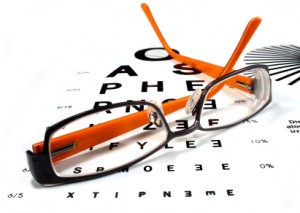This section discusses astigmatism and cylinder. These are two phrases that people who wear glasses often hear, but do not always receive a thorough enough explanation on what they actually mean. Shortly I will try to explain these terms in a simple manner, comprehensible also to those that have not majored in optics and physics during high-school.
‘Astigmatism’ describes a problem that exists in the eye (or, more precisely, in the cornea). The correction of the problem using glasses to cancel out the visual disturbance, the ‘astigmatism’, is known as a ‘cylinder’.
In other words, an eye that does not have ‘astigmatism’ will not require correction with a ‘cylinder’ component in the prescribed glasses. In contrast, an eye with astigmatism will require glasses with a cylinder component (correction) in order to achieve the best possible vision (also called ‘best corrected vision’). Moreover, the degree of the cylinder will be proportional to the degree of the astigmatism, so that one will completely cancel out the other.
To summarize, in general, people can be divided into a few groups. One group is those people who do not require glasses because they are able to see objects at a distance well. These people, until the age of 45, will also see clearly objects that are near without requiring reading glasses (after the age of 45-50, vision for objects that are near by becomes weaker, and they too will require reading glasses). On the other hand, there is another group of people who do not see well without glasses. This group can be further divided into those who are nearsighted (myopic) and those who are farsighted (hyperopic). You can read about each of these topics in the appropriate sections, by clicking each of these links.
Every glasses prescription is composed of numbers that express the strength of those glasses. In fact, each of the two lenses has its own specific prescription, which usually differs between the two eyes of the same individual. This prescription is composed of several numbers, one being the cylindrical component. Both the strength of the glasses, as well as the strength of the cylinder, are measured in units known as diopters and are marked as either positive or negative. As explained just now, the cylinder component is measured in diopters, just like the ‘regular’ power of the glasses. However, unlike the regular component, the cylinder component also receives a value in degrees. These degrees describe the direction of the cylinder, for instance is it oriented horizontally, vertically, or diagonally.
In order to understand what astigmatism and cylinders are, it is not necessary to learn in depth the physics and optics that are associated with these phenomena. Essentially, it is important to understand that the cylinder is one of the characteristic of the prescription of each lens. For example, a person who has glasses with a certain power, but without a cylinder, is not fundamentally different in any way from a person with the same powered glasses, but who also has a cylindrical component. Every person who wears glasses requires that the lenses of the glasses be personally fitted for him/her in order to succeed in correcting their vision to 20/20 (also called ‘6/6’, or 100%’).
It is slightly more difficult for optical stores who dispense glasses to issue glasses with a cylindrical component, since the number of different possibilities (combinations) of lenses with a cylinder is much greater. Therefore, for a person with glasses that have a cylinder component, the store may have to order the lenses from the manufacturer or an importer who keeps a large selection of lenses in stock. For this reason (the necessity to maintain many different prescription combination lenses in stock), and because the lenses of glasses which have a cylinder component are manufactured in much smaller quantities, and are slightly more complex to manufacture, that the price of lenses that have a cylinder component is generally higher. However, at the same time, it is important to emphasize that beyond the technical difficulties related to production, the necessity to keep the lenses in stock and the greater diversity of the lenses with a cylinder component, a person who is first told that he/she “has a cylinder” should not be concerned or feel different as a result of this, since there is no essential difference between people who wear glasses with a cylinder and those who wear glasses but do not require a ‘cylinder’ component. For those who are not yet reassured by this explanation, it may help you to know that there are more people who wear glasses with a cylinder than people who wear glasses without a cylinder. Nevertheless, a large percentage of people who wear glasses with a cylinder component are not aware of it, simply because the topic did not come up for discussion with the optometrist or the ophthalmologist.
If so, what is the significance of having astigmatism which requires glasses with a cylinder component? The answer has to do with the optometrist who will need to perform a slightly longer exam in order to determine and refine the precise prescription for each of your eyes in order to achieve the best possible correction and vision.
Like the power of the refraction in your glasses, so too the power of the cylinder and even its angle may change over the years. There are many people who until a certain age did not require a cylinder component in their prescription, and then it suddenly showed up, and those who required a low cylinder and at some point in their life this component disappeared either temporarily or permanently.
In summary, astigmatism is specific a distortion of the cornea that requires glasses to neutralize. Cylinder is the component in one’s refraction that neutralizes the astigmatism. Many people wear glasses that contain a cylindrical component and most of these are simply not aware of it. Astigmatism is a hassle for your optometrist (requires a longer refraction examination to reach the best possible prescription) and may increase the cost of new lenses for your glasses. Other than that it is merely one component of the glasses prescription that your wear.


